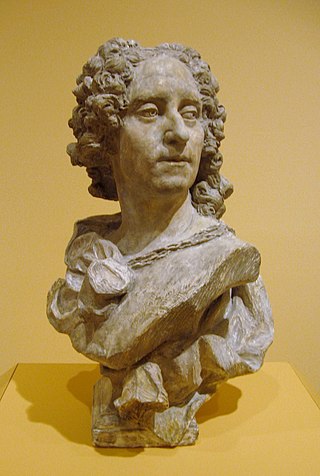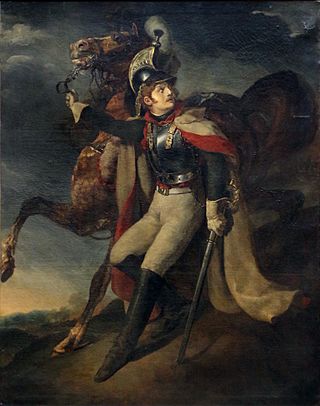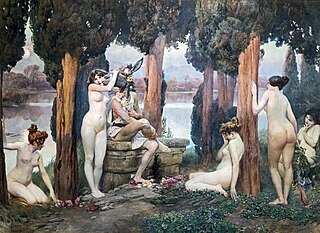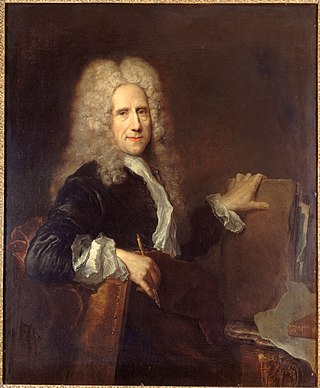Louis Bissinger was a French painter born in Lyon on 24 April 1899. He died on February 25, 1978, in Rillieux-la-Pape. [1]
Louis Bissinger began his career as a musician, playing the cello to make a living. He moved to painting and started with watercolors. He was arrested by the Gestapo in 1943 for helping the French Resistance, and was deported to Germany. He used his painting skills to illustrate the atrocities of concentration camp life in Buchenwald. He survived and organized an exhibition of his war time's artworks when he returned to France. [2]

Louis Laguerre was a French decorative painter mainly working in England.

Pierre-Paul Prud'hon was a French Romantic painter and draughtsman best known for his allegorical paintings and portraits such as Madame Georges Anthony and Her Two Sons (1796). He painted a portrait of each of Napoleon's two wives.

Nicolas Lancret was a French painter. Born in Paris, he was a brilliant depicter of light comedy which reflected the tastes and manners of French society during the regency of the Duke of Orleans and, later, early reign of King Louis XV.

Antoine Coypel was a French painter, pastellist, engraver, decorative designer and draughtsman. He became court painter first to Philippe I, Duke of Orléans, and later to King Louis XV. He became director of the Académie Royale. He was given the title of Garde des tableaux et dessins du roi, a function which combined the role of director and curator of the king's art collection. He was raised to the nobility by the French king. He is known for his history paintings, biblical, mythological and allegorical works, portraits and genre scenes.

Noël-Nicolas Coypel was a French Baroque painter.

Jean-Paul Laurens was a French painter and sculptor, and one of the last major exponents of the French Academic style.

Robert Nanteuil was a French portrait artist: engraver, draughtsman and pastellist to the court of Louis XIV.

Corneille de Lyon was a Dutch painter of portraits who was active in Lyon, France, from 1533 until his death. In France and the Netherlands he is also still known as Corneille de La Haye after his birthplace, The Hague.

Jean Raoux, French painter, was born at Montpellier.

Jean Restout the Younger was a French artist, who worked in painting and drawing. Although little remembered today, Restout was well-respected by his contemporaries for his religious compositions.

Stanislas-Henri-Benoit Darondeau was a French painter, draftsman and engineer who was born in Paris in 1807. The musician Henry Darondeau was his father and Benoît Darondeau one of his brothers.
Pierre-Denis Martin was a French painter of historical subjects, battles, hunts, and architectural views, particularly of royal residences, such as the Palace of Versailles and the Château de Compiègne. He was also known as Martin the Younger or Martin des Gobelins.

Louis Gauffier (1762–1801) was a French painter. Born in Poitiers, he studied in Paris with the history painter Hughes Taraval before entering the Prix de Rome competition which he won in 1779 for Christ and the Woman of Canaan. Apart from a brief return to Paris in 1789 he remained in Italy for the remainder of his life.

The Wounded Cuirassier is an oil painting of a single anonymous soldier descending a slope with his nervous horse by the French Romantic painter and lithographer Théodore Géricault (1791–1824). In this 1814 Salon entry, Géricault decided to turn away from scenes of heroism in favor of a subject that is on the losing side of the battle. On display in the aftermath of France's disastrous military campaign in Russia, this life-size painting captured the feeling of a nation in defeat. There are no visible wounds on the figure, and the title has sometimes been interpreted to refer to soldier's injured pride. The painting stood in stark contrast with Géricault's Charging Chasseur, as it didn't focus on glory or the spectacle of battle. Only his Signboard of a Hoofsmith, which is currently in a private collection, bears any resemblance in form or function to this painting.

Pierre-Antoine Quillard, was a French portrait painter and engraver who worked in Portugal.

Paul-Jean-Louis Gervais was a French painter who was fashionable around the end of the 19th century. He is known for his sensuous paintings of nude women.

Jean-Charles-Alexandre Moreau (1762–1810) was a French history painter, decorative painter and architect. He was born in Rimaucourt near Neufchâteau, Vosges. He studied architecture in Paris with Louis-François Trouard and won the first prize in architecture in the Prix de Rome competition of 1785. He visited Rome four times during his career. Later he studied history painting with Jacques-Louis David. From 1797 to 1810, he exhibited at the Paris Salon. In 1798 he renovated the theatre of the Comédie-Française. According to his entry in the Benezit Dictionary of Artists, Moreau died in 1810 in Paris. However, the German Wikipedia cites a study published in 2014, which shows he is identical to a French architect, who in 1803 moved to Austria, where he was known as Karl Moreau, had a very productive career, and died in 1840.

Jean Mariette was a French engraver and print dealer and publisher. He was the father of Pierre-Jean Mariette.

Paul-Louis Delance (1848–1924) was a French painter and educator. He is known for his allegorical and genre scene paintings early in his career, and his religious, and landscape paintings later in his career.
Jean Raon was a French sculptor who worked mainly for Louis XIV. He is best known for his sculptures placed in the Gardens of Versailles, although he also produced bas-reliefs and pediments.